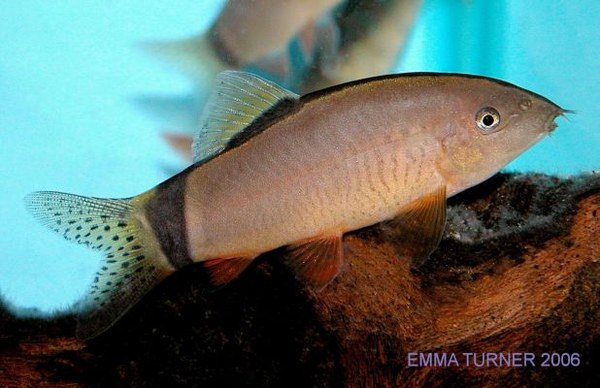Skunk Loach (Yasuhikotakia morleti)
Summary:
Scientific name: Yasuhikotakia morleti
Common name: Skunk loach, Hora's loach.
Synonyms: Botia morleti, Botia horae.
Distribution: Cambodia, Laos, Thailand.
Sexual Dimorphism: Mature females likely to have a rounder abdomen.
Maximum size: 10cm (4").
Similar to: Yasuhikotakia caudipunctata, Yasuhikotakia longidorsalis

Care: Keep in a fairly
sizeable aquarium, and ensure that the substrate is fine and sandy in order to
protect the delicate sensory barbel area. Provide plenty of hiding places in the
aquarium amongst bogwood, caves, and plants. Clean,
well-aerated water is a must.
Feeding: Will accept most brands of dry sinking
catfish pellets, but should be offered a variety of frozen foods to supplement
the diet - mosquito larvae, brineshrimp, and daphnia are usually taken with much
enthusiasm. In the wild, this species feeds on mollusks, and as can probably be
deduced, is a very effective snail eater.
Water parameters: pH: 7.0 or below. Hardness:
Soft and slightly acidic is best. Max dH: <12 degrees.
Temperature: 79ºF to 86ºF (26-30°C)
Breeding: Not known to have been bred in aquaria.
Notes:
Considering its relatively diminutive
size, this is a very feisty loach species, which is not suitable for community
aquariums. Must be maintained in groups of 5 or more in order to spread any
aggression and to allow the fish to form a natural hierarchy.

It is not uncommon to observe this species creating burrows around or
under rocks and other tight crevices. Ensure such structures are stable.
Skunk loaches usually come with an attractively low price tag. However, think very carefully before you purchase, ensuring that you can provide them with the correct tank-mates, conditions and care.
Tank-mates must be robust and
fast-swimming. Can be kept with other moderately aggressive species
such as Yasuhikotakia eos, Y. lecontei, Y. modesta and many of the Syncrossus
(Tiger loach) species. Many fish-keepers report Skunk loaches to be a
crepuscular species, which often remains hidden during the day.
Photo Gallery
Click to view all images of this species! |
|
Document Actions


